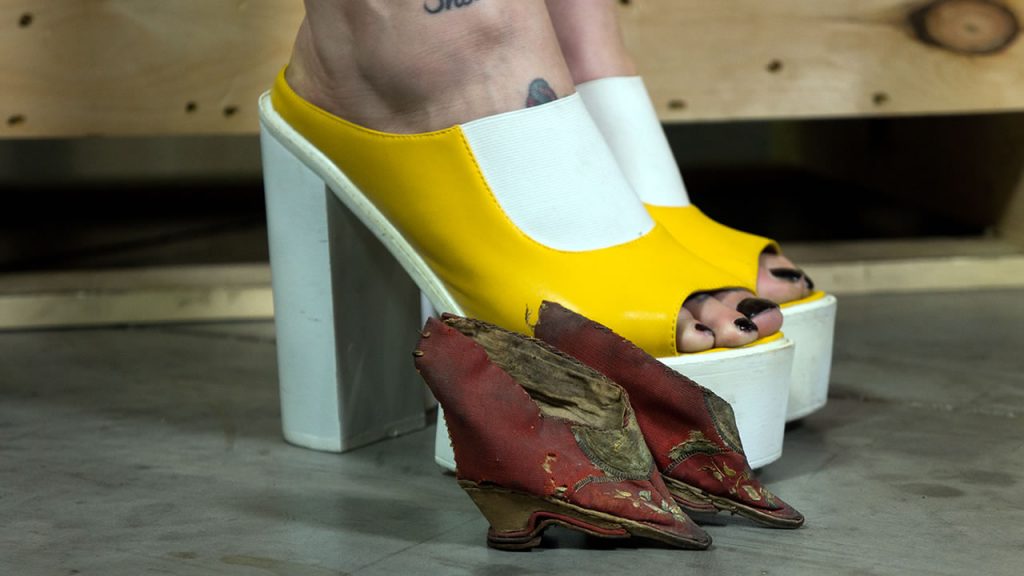Winner of the Fall 2016 StMU History Media Award for
Best Use of Scholarship
Best Article in the Category of “World History”
Best Use of Primary Sources
When I knew I couldn’t suffer another moment of pain and tears fell on my bloody bindings, my mother spoke softly into my ear, encouraging me to go one more hour, one more day, one more week, reminding me of the rewards I would have if I carried on a little longer. In this way, she taught me how to endure—not just the physical trials of footbinding or childbearing, but the more torturous pain of the heart, mind, and soul.1
More often than necessary, women are consumed with the idea of infatuation. Every culture has its own form of standards that pertain to women and what constitutes beauty. Although the world is slightly more accepting now, women used to go to extreme lengths to achieve an image that would be deemed attractive. In the Chinese culture, foot binding was that well-known beauty expectation for centuries. What started off as a celebrity fad, turned into a way of determining social status and eventually an all-around beauty expectation. 2 The objective of foot binding was for women to have the smallest foot possible, starting at very young ages. Not only was this a painful process for girls as young as five years, but it also promoted the idea that women must mutilate their bodies to become appealing to men. At some point in time, women began to just accept that this was something that was supposed to be done in order to be attractive. Often referred to as “lotus boats” or “golden lotuses,” bound feet started as a fad for the famous, and slowly made its way to becoming the social norm.3

This practice began around the tenth century with women in the entertainment business. These women were adored for their tiny arched feet and were seen by men to be much more attractive than middle class women with average feet. As these dancers were gaining an audience, the idea of “lotus feet” was becoming familiar. Not long after these performers expressed their “beauty,” foot binding became a norm for women who wanted to fit in and even for those who had a desire to find a husband.4 This painful process consisted of the breaking of young girl’s toes to form the desired triangular shape. Then the arch of the foot would be bent horizontally from the toes all the way to the heel. As if this was not painful enough, the girls were forced to walk on their feet to intensify the arch, breaking the foot even more. After all of this, the foot would be wrapped to maintain the shape of it as well as prevent any sort of deviation.5

Although this practice was around for centuries, it was only a matter of time before someone realized how inhumane and cruel it really was. Thankfully, many people began to protest against foot binding, forming “anti-foot binding organizations” to raise awareness on the inhumanity of binding women’s feet. By the 1950’s, laws were passed, allowing women to unbind their feet. Although hesitant at first, the trend slowly declined. Many women protested to unbinding their feet, due to the fact that it had been a social norm a thousand years. However, the movement against foot binding continued and eventually the last of the factories that make the tiny shoes were shut down, disabling the women from continuing the custom. Today, foot binding is no longer practiced and the only women who continue to maintain the tiny feet are those elder women who refuse to let go of the past.6
- Lisa See, Snow Flower and the Secret Fan (New York: Random House Publishers, 2005), 3-4. ↵
- Yaodong Gu et al., “Foot Loading Characteristics of Chinese Bound Feet Women: A Comparative Analysis,” PLoS ONE 10, no. 4 (April 2015): 1–9, doi:10.1371/journal.pone.0121695. ↵
- Yu-ning Li, Chinese Women Through Chinese Eyes (New York: Routledge, 2015), 125-127. ↵
- Women in the Middle Ages: An Encyclopedia, 2004, s.v. “Footbinding (Late 10th Century-early 20th Century),” by Patricia Buckley Ebrey. ↵
- Amanda Foreman, “Why Footbinding Persisted in China for a Millennium,” Smithsonian, accessed November 8, 2016, http://www.smithsonianmag.com/history/why-footbinding-persisted-china-millennium-180953971/. ↵
- “Women with Bound Feet in China,” Reshaping the Body: Clothing & Cultural Practice, accessed November 8, 2016, http://exhibits.hsl.virginia.edu/clothes/lady_bound/. ↵



189 comments
Ariette Aragon
This was a short but really good and informative article! I did not know that in China they used to impose foot binding on women. It is sad that throughout history women had been obligated to follow certain laws and stereotypes just to be accepted by society, and by men honestly. Also, I like the images you used because they show the crude reality that Chinese women had to live.
Reba Reyes
I had heard about this in my high school history class. I was not a fan of it at all back then and still am not a fan of it now. It is horrible and abusive to the feet of a women. I like how this article was brief about the topic and was also very informative. I like how the pictures that the author used would show the comparison between a normal foot and a binded foot.
Madeline Emke
I heard briefly about foot binding during my high school history course, but we never truly delved into the reasoning and process of foot binding. As a woman, I understand the desire to be considered beautiful and desirable. I even understand the willingness to go through a little pain to reach that desirable status. For me, I try to exercise in order to stay in shape and I try to maintain a healthy diet in order to be considered beautiful. This can be painful at times, but more in a mental sense because, over time, the physical pain starts to ebb away. But, even with the desire to be beautiful, I cannot imagine binding my feet to make them appear smaller. The thought of trying to walk on my feet after wrapping them so tightly breaks my heart because I can imagine the pain those women must have felt, but their desire to be beautiful overruled their pain.
Reagan Clark
Although this article, I found it informative. Sometimes brief is better. I like how the picture showed the comparison between a normal foot and a foot that has been bounded. I also love the quote that you used at the top. It gave insight to the psyche of women and why they put themselves through this torture. I wonder what started the process. I know that they wanted to have lotus shaped feet, but what made those dancers say: i want my feet to be broken and to cause myself so much agony that it might be considered beautiful? I cannot believe that people forced themselves to go through with this.
Matthew Fabela
Although it was a short article I found it to be very informative on the subject of foot binding. The article gave the origin of the tradition, the effects of it and how China resolved the problem. It’s crazy to think about how many different beauty standards there are around the world and what lengths people will go to achieve them
Cailtin Egolf
I remember learning about this in my high school history class, I remember always wondering and thinking to myself by someone would ever do this to themselves. But in their culture its something highly traditional and beautiful. Same as how in American culture girls get their nails and hair done and boys get their haircuts. To me its just something that is unnatural though because its hard to ever go back.
Raul Colunga
Great article and interesting topic, it is a shame that this started because the king saw a dancer who bound her feet for a dance. He found her feet beautiful and thus started the trend of mothers binding their daughter’s feet for the sake of ‘beauty’. His praise of one dancer had led countless girls to go through torturous experiences.
Micheala Whitfield
This was a very short article, but I love the whole thing. This topic is great! Generations and Generations have passed on this tradition. These women wanted the best for their daughters so bad that they would put them through this pain just to be married to someone of a higher class or for them to make their way to a higher class. What is astonishing is how rooted this tradition became. What I like about the twist of it all, is that it became a sign of endurance, resilience, and strength. A sign of “I can get through anything.” It somehow became an empowerment for them. Good Job.
Hali Garcia
I heard about foot binding when I was in high school and I was learning about what was considered beautiful in different cultures. I enjoyed reading this article because it looks deeper into what it is and I could practically feel the pain that they went through. To me, it is horrific to actually see what the women’s feet looks like after they unbind them. I am so glad that they do not practice it anymore. Great article!
Roberto Rodriguez
It is just crazy to think what people go through to look beautiful, especially woman. It is just disturbing how much they alter the body to fit that image of beauty. This kind of reminds me of the fact that some women who wore corsets in the past, they would wrap their torsos so tight that it would put immense pressure on their inner organs and even in some cases move their organs. It is fantastic to know that foot wrapping is no longer a practice and this self-inflicted pain for an image has stopped.